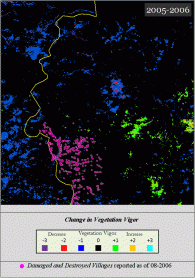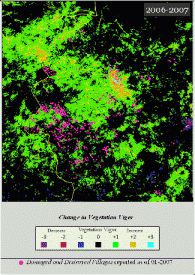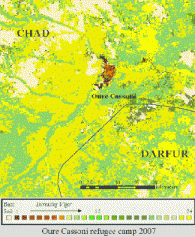Remote sensing applications can measure the health and vigor of vegetation and availability of water, as well as the speed of environmental recovery, and judge the stress humans and their activities place on the environment. Because agriculture and livestock grazing are historically dominant economic and subsistence activities in Darfur, abrupt and dramatic disruptions to these normal patterns of land use are directly related to changes in vegetation coverage as a result of genocidal activities since 2003. We used NASA’s MODIS Terra satellite imagery products to measure change in land cover.
Because the government-sponsored violence included a scorched earth policy, as well as livestock looting, the following images attempt to track evidence of these acts of violence. Clear spatial and temporal correlations are evident between acts of violence and short-term changes to the land cover. We shall see that, especially in West and South Darfur, the displacement of local populations also impacted agricultural production, especially in 2003-04.
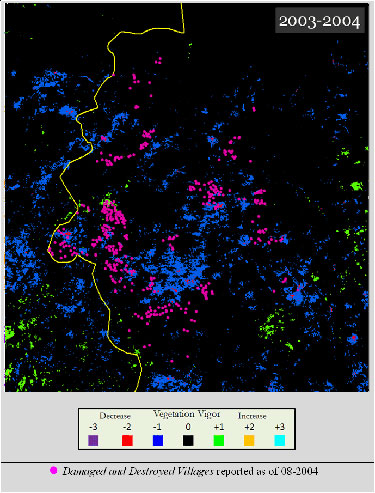 |
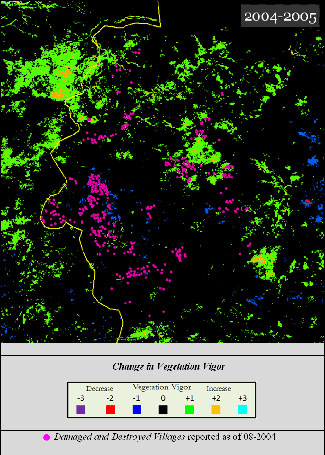 |
Because agriculture generally increases vegetation vigor, the clear annual decreases in vigor observed in West and South Darfur from 2003-04 through 2005-06, corroborate the reduction of agriculture in a predominantly agricultural region. Although a decrease in rainfall from 2003 to 2004 likely contributes to some of the decrease in vegetation vigor, from 2004 through 2006 annual rainfall remains relatively constant. Hence, local violence contributes to some of the more spatially significant trends.
In the high impact zone of West Darfur, which experienced continual violence from 2003 through 2006, the findings show a persistent degradation to the environment in that initial period. But in the sub-Sahara portions of North Darfur, which experienced less concentrated violence and a decrease in grazing, the rebound of vegetation was relatively steady until 2006, when the region experienced again an increase in violence. But by 2007, the vegetation vigor had increased dramatically, in spite of a continual decrease in rainfall.
By 2004, the Darfur crisis has reduced livestock populations, especially sheep, by aerial bombardment in Dar Zaghawa, and looting of animals in Kebkabiya, Kutum, Tawilla, and Korma.(1) In addition, internally displaced persons (IDPs) from the above areas, who managed to escape in May 2004 with some of their animals, could not sustain them and so sold the animals. In the following example, we show that from 2004 to 2005, vegetation coverage and vigor increases in the affected region. This rebound in vegetation coverage, likely grasses and shrubs, came in spite of a slight decrease in annual rainfall for this region in 2005.
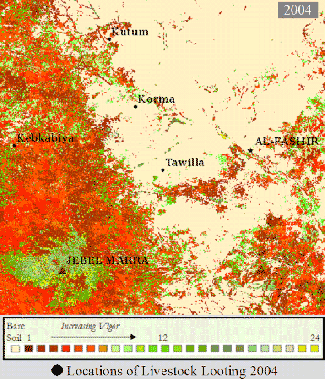 |
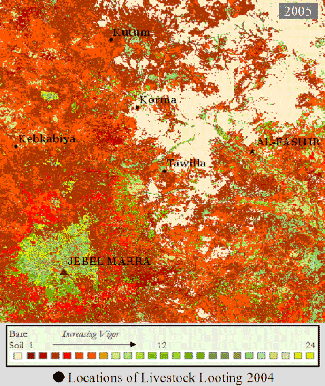 |
The short-term patterns appear to show that the immediate violence negatively impacts the vegetation, but if the violence decreases, the vegetation rebounds by the following year regardless of rainfall. Where violence is continuous, though, the negative impact on vegetation persists. However, there are long-term trends as well, which are discussed in Long-term Increases in Vegetation Due to the genocide in Darfur, 2003-2007.
Crowded refugee camps in Darfur and Chad are another direct result of the genocide. In August 2005, the United Nations Office for the Coordination of Humanitarian Affairs (OCHA) issued a report stating that there were just over 1.8 million IDPs in Darfur.(2) In November 2005, the office of the High Commissioner for Refugees (UNHCR) reported another 200,000 registered refugees from Darfur located in eastern Chad.(3)
Livestock are absolutely fundamental to the people of eastern Chad but the influx of refugees from Darfur with approximately 600,000 of their own animals resulted in conflict over the already sparse resources.(4) In late 2007, villagers in Chad claimed their own animals were dying of starvation in increased numbers because of diminishing grazing ranges, particularly in the dry season. Earlier in 2007, 30 percent of all livestock in one refugee camp, Oure Cassoni, died of starvation.(5) This negative impact on vegetation is also detectable using remote sensing shown in the following image.
1. Food and Agriculture Organisation of the United Nations in Collaboration with the North Darfur Veterinary Department, North Darfur Livestock Coordination Workshop: Proceedings and Recommendations. El Fashir, March 20-23, 2005, p. 3.
2. United Nations Office for the Coordination of Humanitarian Affairs, Darfur Humanitarian Profile. Nr. 17, August 2005: Table A; cited in Coalition for International Justice, Soil and Oil: Dirty Business in Sudan. Coalition for International Justice, Washington D.C., February 2006, p. 79.
3. United Nations High Commissioner for Refugees, Sudan/Chad Situation Update. Nr. 38, November 2005: p. 12; cited in Coalition for International Justice, Soil and Oil: Dirty Business in Sudan. Coalition for International Justice, Washington D.C., February 2006, p. 79.
4. SPANA: Society for the Protection of Animals Abroad, “Livelihoods from Livestock” is Message from Darfur Refugees—UNHCR Calls in British Veterinary Charity. London – October 10, 2007.
5. SPANA: Society for the Protection of Animals Abroad, “Livelihoods from Livestock” is Message from Darfur Refugees—UNHCR Calls in British Veterinary Charity. London – October 10, 2007.
